Abstract
The earthquakes happened around the world have brought irreparable damage to humans. In order to reduce losses, scholars from all over the world are committed to studying the information contained in the magnetotelluric signals. The detecting instrument arranged in the field or in the Seismological Bureau station are usually interfered by noises, so the problem of how to remove these noise is the research content of this paper. This paper is based on the wavelet transform and fast Fourier transform, and it first uses the appropriate wavelet base to decompose the signal in multi-level, and then uses the fast Fourier transform to obtain the spectrum of signal in each layer, then uses the spectrum to select the appropriate decomposition order, and carries out threshold de-noising on signal, finally reconstructs and calculates the signal after noise reduction. In this paper, the principle and steps of dealing with the signal are given out, and the analog signal and measured signal are simulated through MATLAB, so as to verify the effectiveness. The results show that, the wavelet transform has good effect in dealing with the magnetotelluric signal, which can remove the noise signal well and keep the energy characteristic of the original signal, and is convenient for follow-up analysis.









Similar content being viewed by others
References
Wang, R., Jiang, T.: Analysis of major natural disasters in the twentieth century. J. Nat. Disasters 9(4), 9–15 (2000)
Niwa, S., Yasukawa, H., Takumi, I., et al.: The precursor signal detection from electromagnetic waves for predicting great earthquakes using Kalman filter. In: Geoscience and Remote Sensing Symposium, 2003. IGARSS ‘03. Proceedings. 2003 IEEE International, pp. 3620–3622 (2003)
Yasukawa, H., Niwa, S., Hata, M., et al.: In: Signal Processing Conference, 2002 11th European. IEEE, pp. 1–4 (2002)
Lian, Y.: Research on denoising wavelet packet transform to signal based on electric field. Northeast Agricultural University, Harbin (2014)
Sharma, G.K., Bhagi, S., Thirunavukkarasu, S., et al.: Wavelet transform-based approach for processing ultrasonic B-scan images. Insight Non-Destruct. Test. Cond. Monit. 59(2), 93–99 (2017)
Parmar, K., Kher, R.K., Thakkar, F.: Analysis of CT and MRI image fusion using wavelet transform. In: International Conference on Communication Systems and Network Technologies. IEEE, pp. 124–127 (2012)
Rajkumar, S., Bardhan, P., Akkireddy, S.K., et al.: CT and MRI image fusion based on wavelet transform and neuro-fuzzy concepts with quantitative analysis. In: International Conference on Electronics and Communication Systems. IEEE, pp. 1–6 (2014)
Saha, S., Mukherjee, D., Mukhopadhyay, S.: Online detection and location estimation of earthquake events using continuous wavelet transform. In: IEEE First International Conference on Control, Measurement and Instrumentation. IEEE, pp. 77–82 (2016)
Li, Y., Qin, F., Zhou, Z.: Application of improved wavelet transform algorithm in noise reduction of seismic data. Software 6, 40–43 (2013)
Antaresti, T., Nugraha, A.S., Putra, I.P.E.S., et al.: Wavelet denoising and fractal feature selection for classifying simulated earthquake signal from mobile phone accelerometer. In: International Multi-Conference on Systems, Signals & Devices. IEEE, pp. 1–7 (2014)
Zhang, X., Li, J., Wang, J.: A fast seismic data processing approach based on parallel wavelet transform. In: IEEE International Conference on Progress in Informatics and Computing, Vol. 1, pp. 564–567 (2010)
Suprijanto, Istiana, T., Hariyanto, et al.: Detection of P-wave on broadband seismometer using discrete wavelet denoising. In: International Conference on Instrumentation Control and Automation. IEEE, pp. 110–114 (2014)
Wang, X., Mingjun, S., Liu, J., et al.: Seismic coherence cube algorithm and its application based on wavelet transform. Geophys. Prospect. Pet. 41(3), 334–338 (2002)
Ye, Z.: Wavelet coherence technique and its application in seismic interpretation. Chengdu University of Technology, Chengdu (2006)
Chen, Z., Deng, J., Chen, H., et al.: Research on magnetotelluric signal denoising based on wavelet transform. Chin. J. Eng. Geophys. 9(6), 732–737 (2012)
Gurley, K.: Application of wavelet transform in earthquake, wind, and ocean engineering. Eng. Struct. 21(2), 149–167 (1999)
Han, P., Hattori, K., Huang, Q., et al.: Evaluation of ULF electromagnetic phenomena associated with the 2000 Izu Islands earthquake swarm by wavelet transform analysis. Nat. Hazards Earth Syst. Sci. 11(3), 965–970 (2011)
Balafas, K., Kiremidjian, A.S.: Development and validation of a novel earthquake damage estimation scheme based on the continuous wavelet transform of input and output acceleration measurements. Earthq. Eng. Struct. Dynam. 44(4), 501–522 (2015)
Han, B., Zhao, G., Tang, J.: Research on wavelet transform and its application in anomaly extraction of seismic electromagnetic signals. In: China Joint Academic Earth Science Annual Meeting (2014)
Xie, T., Du, X., Liu, J., et al.: Analysis of earthquake electromagnetic signal wavelet energy spectrum like Wenchuan M_S8.0&Haiti M_W7.0. Earthq. Sci. 35(1), 61–71 (2013)
Liu, J.X., Han, S., Ma, J.: Application of wavelet analysis in denoising of seismic data. Progr. Geophys. 21(2), 541–545 (2006)
Cai, J., Li, J.: Magnetotelluric signal processing power interference based on wavelet denoising in frequency domain. Geol. Explor. 51(2), 353–359 (2015)
Wu, F.M., Yang, Y.X.: GPS/INS integrated navigation based on wavelet threshold denoising adaptive filter. Acta Geodaetica et Cartographica Sinica 36(2), 124–128 (2007)
Acknowledgements
This work was supported by Jiangsu Province Natural Science Foundation (No. BE2016805), The Spark Program of Earthquake Technology of CEA (No. XH17013) and National Natural Science Foundation (Nos. 61503081, 61473079).
Author information
Authors and Affiliations
Corresponding author
Rights and permissions
About this article
Cite this article
Lu, Y., Huang, Y., Xue, W. et al. Seismic data processing method based on wavelet transform for de-noising. Cluster Comput 22 (Suppl 3), 6609–6620 (2019). https://doi.org/10.1007/s10586-018-2355-0
Received:
Revised:
Accepted:
Published:
Issue Date:
DOI: https://doi.org/10.1007/s10586-018-2355-0




